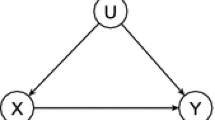Abstract
Procedures are given for determining identified parameters, finding constraints on the covariances, and checking equivalence, in acyclic (recursive) linear path models with correlated error terms (disturbances), by inspection of the path equations, aided by simple recursions. This provides a useful and general alternative to the employment of directed acyclic graph theory for such purposes.
Similar content being viewed by others
References
Anderson, J.C., & Gerbing, D.W. (1988). Structural equation modeling in practice: A review and recommended two-step approach.Psychological Bulletin, 103, 411–423.
Bentler, P.M. (1985).Theory and implementation of EQS: A structural equations program (Manual for program version 2.0). Los Angeles, CA: BMDP Statistical Software.
Blalock, H.M. (1962). Four-variable causal models and partial correlations.American Journal of Sociology, 68, 182–194.
Bollen, K.A. (1989). Outlier screening and a distribution-free test for vanishing tetrads.Sociological Methodology and Research, 19, 80–92.
Bowden, R.J., & Turkington, D.A. (1984).Instrumental variables. Cambridge, MA: Cambridge University Press.
Jöreskog, K.G., & Sörbom, D. (1979).LISREL VI: Analysis of linear structural relationships by maximum likelihood, instrumental variables, and least squares. Uppsala, Sweden: University of Uppsala.
Kenny, D.A. (1974). A test for a vanishing tetrad: The second canonical correlation equals zero.Social Science Research, 3, 83–87.
Lee, S., & Hershberger, S.A. (1990). A simple rule for generating equivalent models in covariance structure modelling.Multivariate Behavioral Research, 25, 313–334.
McDonald, R.P. (1978). A simple comprehensive model for the analysis of covariance structures.British Journal of Mathematical and Statistical Psychology, 31, 59–72.
McDonald, R.P. (1980). A simple comprehensive model for the analysis of covariance structures: Some remarks on applications.British Journal of Mathematical and Statistical Psychology, 33, 161–183.
McDonald, R.P. (1997). Haldane's lungs: A case study in path analysis.Multivariate Behavioral Research, 32, 1–38.
Pearl, J. (1988).Probabilistic reasoning in intelligent systems. San Mateo, CA: Morgan Kaufmann.
Pearl, J. (1998). Graphs, causality, and structural equation models.Sociological Methods and Research, 27, 226–284.
Pearl, J. (2000).Causality: Models, reasoning and inference. Cambridge, MA: Cambridge University Press.
Raykov, T., & Penev, S. (1999). On structural equation model equivalence.Multivariate Behavioral Research, 34, 199–244.
Scheines, R., Spirtes, P., Glymour, C., Meek, C., & Richardson, T. (1998). The TETRAD project: constraint based aids to causal model specification.Multivariate Behavioral Research, 33, 65–117.
Shipley, B. (2000). A new inferential test for path models based on directed acyclic graphs.Structural Equation Modeling, 7, 206–218.
Simon, H.A. (1953). Causal ordering and identifiability. In W.C. Hood & T.C. Koopmans (Eds.),Studies in econometric method (pp. 49–74). New York, NY: Wiley.
Spirtes, P., Richardson, T., Meek, C., Scheines, R., & Glymour, C. (1998). Path diagrams as a structural equation modeling tool.Sociological Methods and Research, 27, 182–225.
Stelzl, I. (1986). Changing a causal hypothesis without changing the fit: Some rules for generating equivalent path models.Multivariate Behavioral Research, 21, 309–331
Strotz, R.H., & Wold, H.O.A. (1960). Recursive versus nonrecursive systems: An attempt at synthesis.Econometrica, 28, 417–427.
Verma, T.S., & Pearl, J. (1990). Equivalence and synthesis of causal models. In P.P. Bonissone (Ed.),Uncertainty in artificial intelligence (pp. 220–227). Cambridge, MA: Elsevier Science.
Wright, S. (1921). Correlation and causation.Journal of Agricultural Research, 21, 557–585.
Author information
Authors and Affiliations
Corresponding author
Additional information
Thanks are due to Judea Pearl for his guidance through all phases of this work, and to Larry Hubert for his careful reading of the manuscript. Any errors that remain are solely the responsibility of the author.
Rights and permissions
About this article
Cite this article
McDonald, R.P. What can we learn from the path equations?: Identifiability, constraints, equivalence. Psychometrika 67, 225–249 (2002). https://doi.org/10.1007/BF02294844
Received:
Revised:
Issue Date:
DOI: https://doi.org/10.1007/BF02294844




